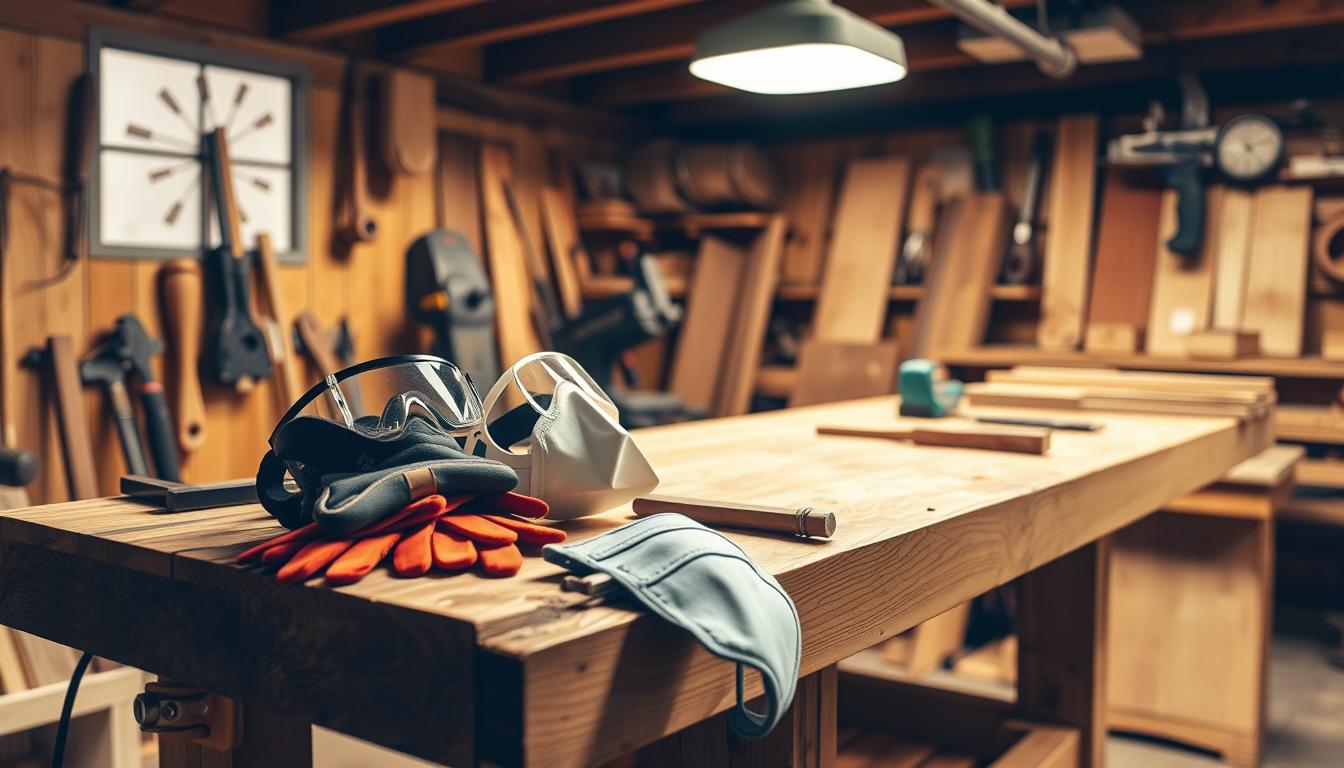Woodworking brings a unique joy, turning raw wood into something useful and beautiful. As a beginner, I see why it’s so captivating. Every step, from cutting to polishing, makes my creations more special. But, it also means I must keep my workshop safe and productive1.
Adding woodworking to your skills can grow your business. It attracts new clients and keeps them coming back. But, it also means being extra careful and following safety tips every day1.
Lastly, having General Liability insurance is not just a good idea. It’s the safety net that lets me focus on my craft without worry
Table of Contents
ToggleKey Takeaways:
- Beginner woodworkers must rigorously apply woodworking safety tips to prevent injuries and maintain a productive workshop.
- Proper use of safety equipment and maintaining a clear and focused mindset are paramount for safety in the workshop.
- Regular tool maintenance, sharp blades, and organized workspaces constitute best practices for workshop safety.
- Avoiding the use of substances before and during woodworking activities can significantly reduce the risk of accidents.
- Staying proactive with a comprehensive handyman risk management plan that includes woodworking services can effectively manage new risks1.
- Investing in the right business insurance, including General Liability coverage, is non-negotiable for financial protection and peace of mind1.
>>Get 16,000 Woodworking Plans
Understanding the Importance of Safety in Woodworking
In woodworking, knowing about woodworking hazards and using workshop safety precautions is key. It’s not just good practice; it’s a must to stay safe. A huge 98% of accidents can be prevented by following simple safety rules3. This shows how vital it is to always be careful about safety.
The Risks Associated with Woodworking
Not following safety rules can hurt your health and even cause work stoppages due to fines4. So, it’s important to have strong safety measures to keep you safe and your work going.
Why Safety Gear is Essential
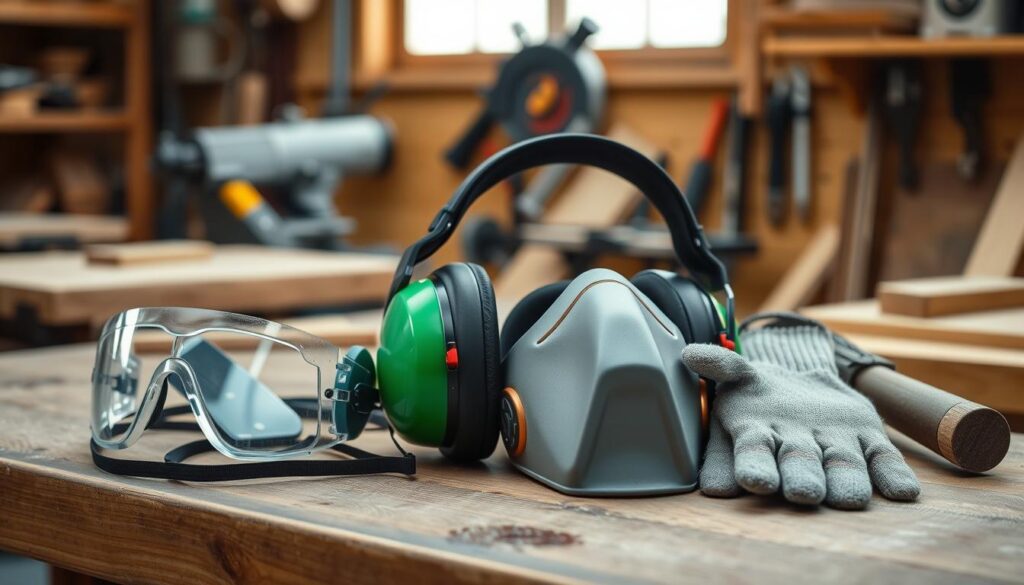
Essential Personal Protective Equipment (PPE)
Woodworking is a craft that needs safety first. It’s important to wear the right Personal Protective Equipment (PPE). This keeps your eyes, ears, and lungs safe from harm.
Choosing the Right Safety Glasses
Benefits of Hearing Protection
Wearing Respirators for Dust Protection
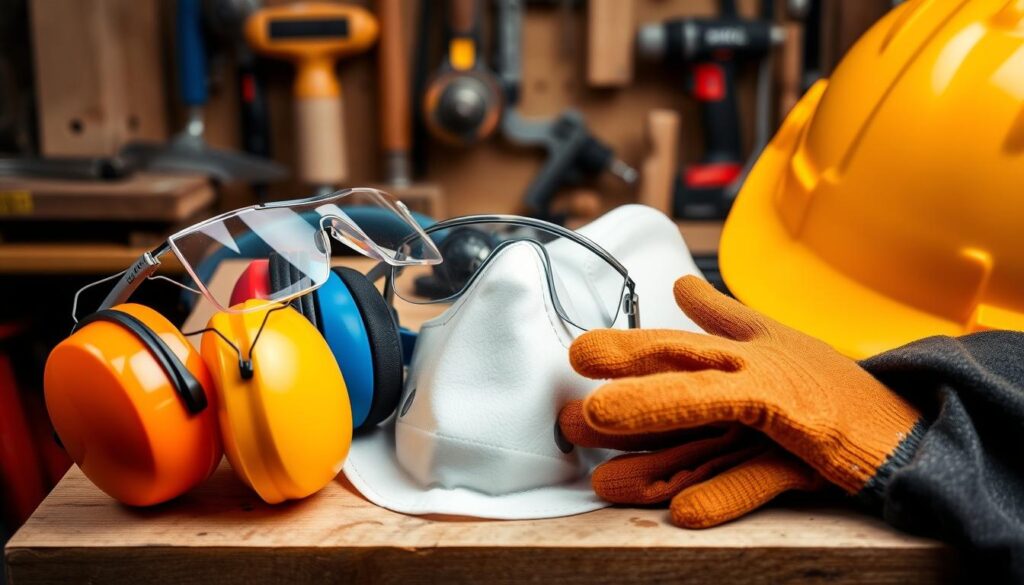
Whether you’re new or experienced, wearing PPE is a must. It keeps you safe and helps you do better work.
Safe Use of Tools and Equipment
Keeping tools and machinery safe in woodworking is key to a safe work environment. It’s not just about following rules. It’s about making sure everyone stays safe. I focus on Tool Safety, Preventative Maintenance, and Woodworking Techniques to prevent injuries.
Familiarizing Yourself with Tool Safety Features
It’s important to know how each tool works and what risks it has. For example, knowing how to avoid kickback from table saws is crucial. Also, using routers correctly is vital to avoid accidents. Each machine should have a switch that locks it off to stop unauthorized use8.
Correct Techniques for Hand Tools
Using hand tools right is not just about skill. It’s about staying safe. The right grip and handling can prevent slips and injuries. Woodworkers use many tools, and knowing how to use them safely is key9.
Maintenance Tips for Power Tools
| Tool Type | Safety Feature | Maintenance Required |
|---|---|---|
| Table Saw | Kickback Guards | Regular blade inspections, ensure guards are functioning |
| Routers | Auto-shutoff | Check motor brushes and clear dust build-up |
| Chisels | Correctly sized handles | Frequent sharpening, handle checks |
Following these safety steps and maintenance tips creates a safe and efficient work environment. Both new and experienced woodworkers will benefit. For more safety tips and techniques, check out this detailed guide on tool safety in woodworking8.
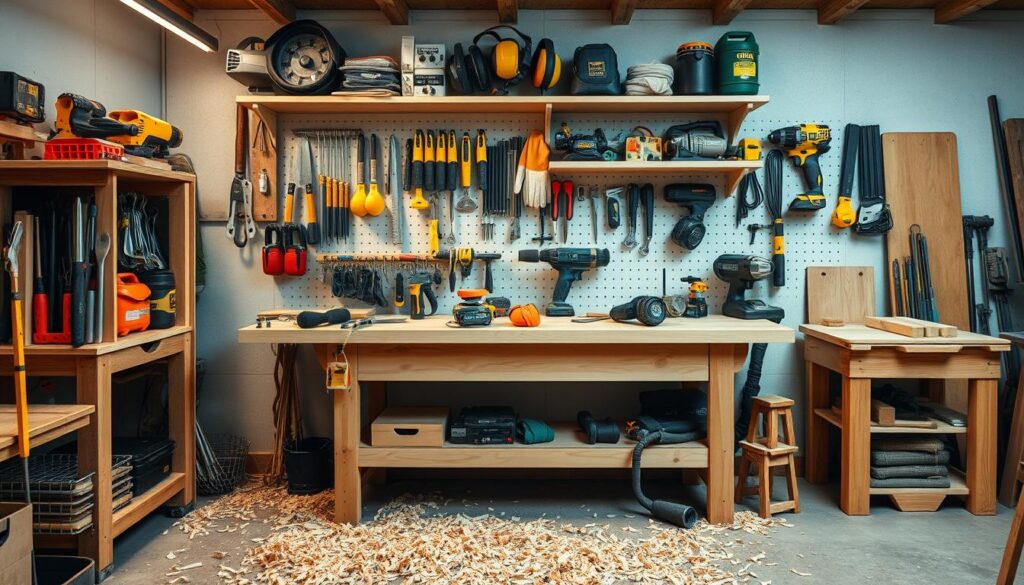
Establishing a Safe Workspace
Creating a safe and organized workspace is key in woodworking. It affects both safety and how well you work.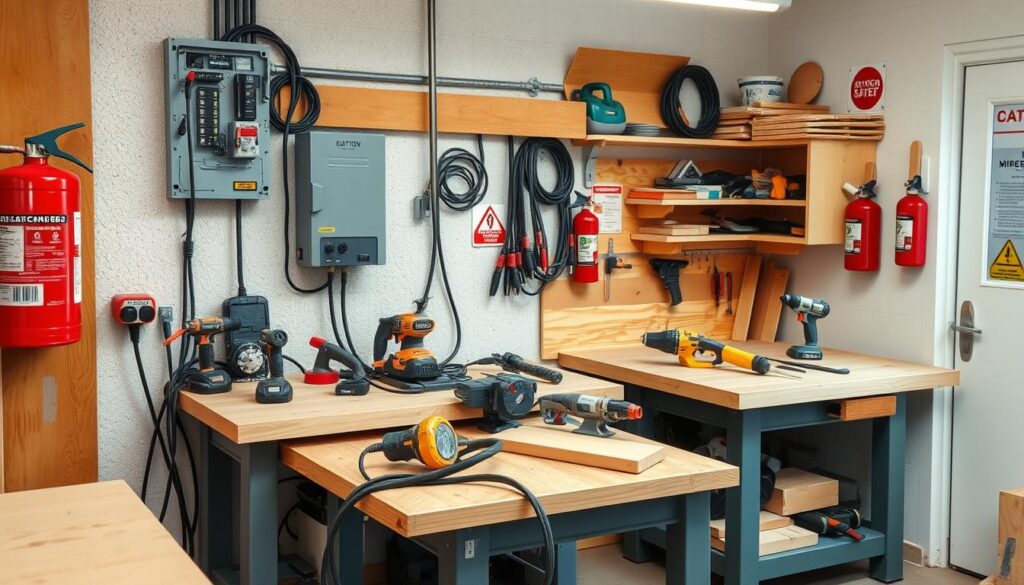
Organizing Your Work Area Effectively
Keeping your workshop tidy is crucial for safety. A clean space helps avoid accidents from clutter. Regular checks on tools and equipment are important to keep them running smoothly and safely10.
Also, a neat workspace lowers the chance of falls and other accidents11.
Importance of Good Lighting
Lighting in woodworking is more than just brightness. It makes your work area safe and efficient. Good lighting helps you do detailed tasks without mistakes, which can hurt you.
It makes sure you can see and move around safely in your workshop.
Managing Electrical Hazards
Electrical safety is a big deal in woodworking. It means keeping electrical systems safe to avoid shocks or fires. Using one big extension cord keeps things tidy and safe from tripping hazards.
It’s also important to manage cables well and check them often for damage. This keeps your electrical setup safe.
In short, a well-organized workspace with good lighting and electrical safety is better for efficiency. It also lowers the risk of accidents and injuries in woodworking.
Best Practices for Lifting and Carrying Wood
Woodworking requires mastering safe lifting techniques for efficiency and injury prevention. Knowing how to handle heavy materials is key to safety and extending your projects.
>>Get 16,000 Woodworking Plans
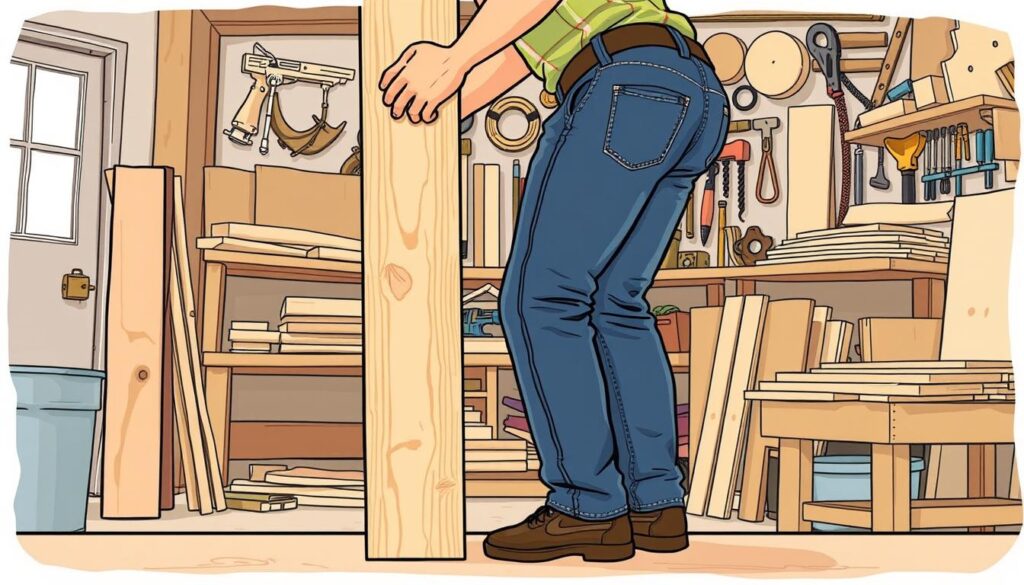
Leveraging Leg Strength
Using your legs, not your back, is crucial when lifting heavy wood or machinery. This method reduces back injury risks. Squat down, keep the weight close, and lift by straightening your legs.
Ensuring Stability and Grip
Before lifting, ensure a stable footing and a firm grip. Adjust your grip based on the material’s size and shape. For big items, having a buddy can make lifting safer and more efficient.
Avoiding Strains and Injuries
Avoid Overreaching
Overreaching can cause muscle strains and ligament sprains. Always check if the material is within reach before moving it. If it’s too far, move closer or use a cart.
Handling Weight Appropriately
Assess the material’s weight and decide if you need help. Carrying too much can lead to immediate and long-term injuries. About 25% of woodworking injuries are due to bad lifting and carrying12.
Following these safe lifting techniques and proper material handling is crucial. It helps avoid injuries and keeps your projects safe and uninterrupted.
Keeping Children and Pets Safe
Creating a safe woodworking environment is key. Woodworking can be fun but also has dangers. It’s important to keep children and pets safe.
Setting Boundaries Around the Work Area
Setting clear boundaries is crucial. Kids and pets can get curious and wander. Tools left out can be dangerous.
Older homes may have lead paint or asbestos. These can be very harmful. Using barriers around tools helps keep everyone safe.
Importance of Open Communication
Talking openly is vital. Explain the dangers of woodworking to kids. This helps them understand and stay away.
When pets are around, kids should watch for signs of stress. This can help avoid accidents.
Changes during remodeling can stress pets and kids. Keeping routines the same helps. Training pets and keeping them calm is also important.
In summary, woodworking can be fun for families. But safety rules are essential. They teach everyone how to stay safe in a creative but dangerous space.
Emergency Preparedness
In woodworking, being ready for emergencies is key. Knowing how to handle first aid and emergency responses can lower injury risks. It’s about being proactive and prepared, not just reacting.
First Aid Kits: What to Include
Every woodshop needs a first aid kit for woodworking hazards. It should have bandages, antiseptics, and burn creams. For serious injuries, having absorbent dressings and hemostatic agents is crucial.
- Bandages and gauze for cuts or abrasions
- Antiseptic wipes and creams to prevent infection
- Burn creams for any accidental burns from equipment
- Eye wash solution to flush out wood dust or debris
Knowing Emergency Numbers
Knowledge is as important as physical tools in emergency response. Keep a list of emergency contacts handy. This includes local services, medical facilities, and poison control. A good emergency plan ensures quick action in serious incidents.
| Emergency Service | Contact Number |
|---|---|
| Local Police Station | 102 |
| Nearest Hospital | 103 |
| Poison Control | 101 |
Handling accidents well is important. But, preventing them is even more crucial. Use sharp, well-maintained tools and stay focused to avoid accidents16.
A well-prepared woodshop is safer, more productive, and legally sound.

Understanding Material Handling Safety
In woodworking, keeping materials safe is key to a healthy work area. Today, I’m focusing on the basics of safety with wood and chemicals. This is to help carpenters and hobbyists protect themselves and their workspaces.
>>Get 16,000 Woodworking Plans
Safe Stacking and Storing Lumber
Wood Storage is vital to avoid injuries and make the most of workshop space. Stacking wood right keeps the area neat and safe. It’s important to use strong platforms or racks for wood storage.
Wood should be stacked flat and tied down to prevent falls. OSHA’s General Industry Standard 1910.176(a) says to keep enough space around storage for easy access17.
Recognizing Chemical Hazards
Hazardous Chemicals in Woodworking are a big risk. Many woodworking tasks involve chemicals that can harm health if not handled right. For example, stains, adhesives, and finishes have VOCs that need good air flow to avoid breathing problems.
Using safety measures and handling chemicals carefully is crucial for my health and career in woodworking. It’s also important to store these chemicals in safe, labeled containers to avoid spills and accidents.
| Factor | Safety Precaution | Impact |
|---|---|---|
| Wood storage stability | Use of sturdy racks/platforms | Prevents injury from falling wood |
| Hazardous Chemical Handling | Use of Gloves and Proper Ventilation | Protects from chemical hazards |
Knowing about wood stack stability and chemical safety helps me stay safe and protect others too.
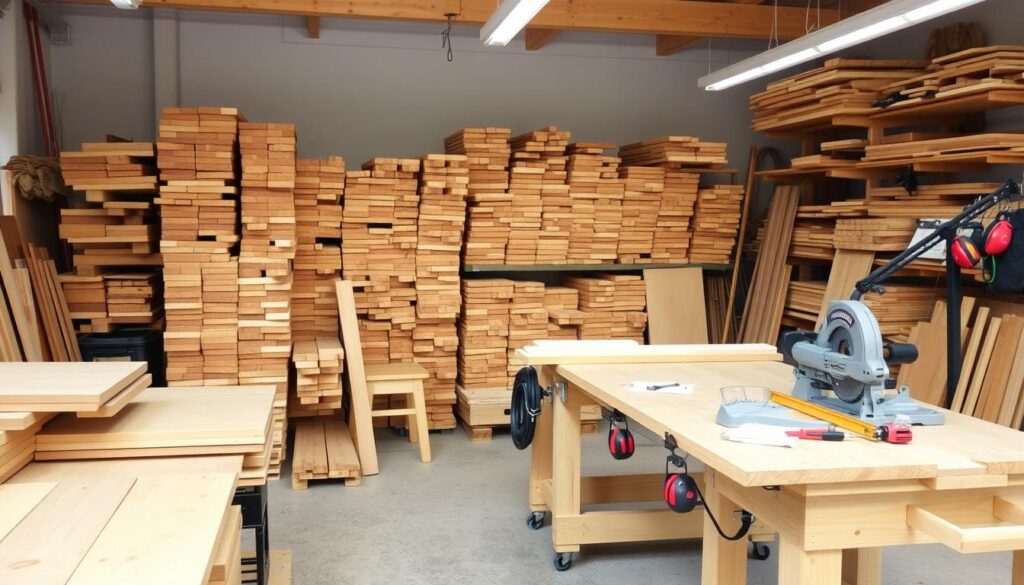
In conclusion, knowing about Material Safety in woodworking is both theoretical and practical17. This approach improves my skills and creates a safe woodworking culture.
Learning the Importance of Proper Technique
In woodworking, learning the right techniques is key. It’s not just about getting better at woodworking. It’s also about staying safe. Using the right methods helps avoid accidents and keeps your workspace safe.
The Role of Technique in Preventing Accidents
Knowing how to use tools correctly can prevent many injuries. For example, using tools the right way can prevent strain and accidents. Always keep safety features on power tools like table saws and miter saws18.
Tools like routers and saws need extra care. Use featherboards and splitters to control them and avoid kickback19.
Practicing on Scrap Wood

By focusing on skill development and careful practice, you improve your work and stay safe. The right mix of technique and safety makes woodworking safer and more rewarding for everyone.
Importance of Continuous Education
In woodworking, technology and safety rules keep changing. This makes ongoing learning very important. By taking safety courses and joining woodworking groups, professionals keep up with new safety rules.
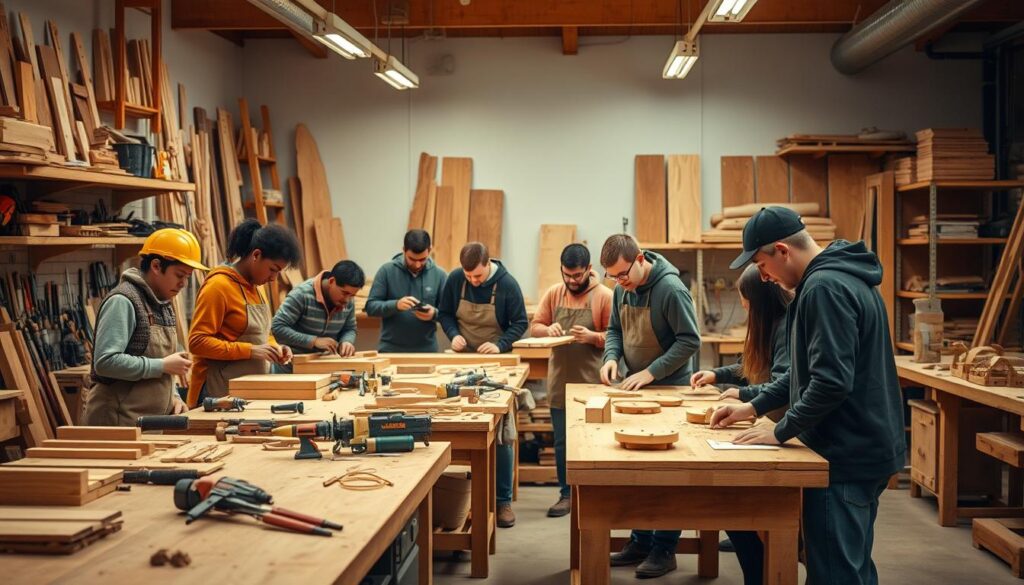
Resources for Woodworking Safety Training
Safety training is key to fewer accidents and a safer woodworking community. There are many resources like online lessons, manuals, and certified courses. These help people learn how to use machines safely and do regular checks on them20.
Joining Woodworking Clubs and Workshops
Being part of woodworking clubs and workshops is very helpful. It lets people share tips and learn about new things. It’s good for everyone, from newbies to experts.
Workshops led by experienced woodworkers give hands-on learning. This helps prevent injuries and strains20.
| Training Program | Focus Area | Benefits |
|---|---|---|
| OSH Professional | Overall Safety Management | Comprehensive safety overview, risk management skills |
| Machine Safeguarding | Equipment Handling | Reduces risk of injuries from inadequate machine guarding21 |
| Hazard Communication | Chemical Safety | Enhances knowledge about chemical hazards, ensuring proper handling21 |
| Personal Protective Equipment | Usage of Safety Gear | Education on proper gear increases protection against multiple hazards20 |
Learning and growing in woodworking is a never-ending journey. Mastering safety through training and community involvement is crucial for every woodworker.
Recognizing and Reporting Unsafe Conditions
In my woodworking, staying alert for safety risks is key. This helps keep our workshop safe and lowers the chance of accidents. Regular safety checks and reporting hazards are essential.
Keeping An Eye Out for Hazards
Also, making sure tools are checked every month has cut down on malfunctions. This has reduced cuts or scrapes23.
Understanding Whistleblower Protections
Reporting hazards safely is very important to me. Knowing I’m protected as a woodworker makes it easier to talk about safety issues. This lets us all work together to stay safe24.
| Type of Hazard | Reporting Procedure | Safety Measure |
|---|---|---|
| Cluttered Workspaces | Immediate notification to supervisor | Regular clean-up schedules |
| Defective Equipment | Fill out a hazard report form | Monthly inspection and maintenance |
| Improperly Stored Chemicals | Document and describe risks | Correct labeling and secure storage |
| Electrical Hazards | Report to facility’s manager | Regular wiring checks; updating old installations |
By following these steps, we help make our woodworking community safer. It’s crucial for us to keep our workshops safe. This way, creativity can flourish without risks.
>>Get 16,000 Woodworking Plans
Developing a Personal Safety Checklist
Starting any woodworking project, I always put safety first. Before I begin, I go through my Personal Safety Plan carefully. This step keeps me safe and ensures the safety of those around me.
Daily Safety Checks Before Starting Work
Every day, I review Safety Protocols before starting work. I make sure only trained people are using the woodshop. I also check if someone is watching during work sessions.
I look to see if the shop is open during safe hours. This is important because accidents can happen during certain times. I also make sure all safety devices are working properly.
Customizing Your Own Safety Guidelines
I create a Woodworking Checklist that fits my workspace. I check if I need someone with me when using power tools after hours. I also make sure I’m working during safe hours.
I check the Fire Extinguisher and Eyewash solution on the west wall. I make sure my work area is clean and ready. I also report any safety issues right away. This helps create a safe work environment.
FAQ
What should a beginner know about woodworking safety?
A beginner should know about the dangers of woodworking. Accidents can happen with tools or health issues from dust and chemicals. It’s key to follow safety rules, wear the right gear, keep your space tidy, and use tools right to avoid injuries.
Why is safety gear essential in woodworking?
Safety gear is vital to protect woodworkers from dangers in woodworking. Safety glasses protect eyes from debris, and ear protection guards against loud noises. Respirators are crucial to avoid breathing in sawdust and harmful fumes from finishes, making them a must for workshop safety.
How do you choose the right safety glasses for woodworking?
When picking safety glasses, look for impact-resistant lenses to guard against flying debris. They should fit well and be comfy for long use. Also, consider anti-fog features if you work in humid places. Make sure they work well with other PPE like earmuffs and respirators.
What are the benefits of hearing protection in a woodshop?
Hearing protection prevents hearing loss from loud tool noises. Earplugs or earmuffs reduce the risk of tinnitus and other hearing problems. This keeps woodworkers’ hearing safe.
Why is wearing a respirator important when woodworking?
Wearing a respirator or dust mask is key to avoid breathing in harmful sawdust and chemicals. These can cause respiratory issues. A respirator with the right filter protects your lungs from damage and irritation from woodworking materials.
What should I know about tool safety features?
Knowing your tools’ safety features is crucial to avoid accidents. Get familiar with guards, kickback prevention, and emergency off switches. Always read the manual for each new tool to understand these features and how to use the tool safely.
How should hand tools be used correctly?
Hand tools should be used with proper techniques to prevent injury. Hold them firmly, keep hands away from the edge, and cut away from your body. Regularly check tools for wear and keep them sharp for safer use.
Can you provide maintenance tips for power tools?
To keep power tools in good shape, keep them clean and check for dull blades. Regularly inspect for damaged parts. Store tools properly when not in use and follow the manufacturer’s guidelines for service and repairs.
How should I organize my work area effectively?
Organize your work area by keeping it clean and storing tools and materials within reach but out of the way. Ensure clear pathways to prevent tripping. Good organization saves time and keeps you focused on safety.
Why is good lighting important in the woodworking workspace?
Good lighting is essential in woodworking to reduce eye strain and improve precision. It also prevents accidents by increasing visibility. Make sure work areas, especially those for detailed work, are well-lit with the right fixtures.
How can electrical hazards be managed in a woodshop?
Manage electrical hazards by organizing cords and keeping them away from high-traffic areas. Use a single heavy-duty extension cord for all tools. Regularly inspect tools and cords for damage and replace them if faults are found.
What techniques can I use for lifting heavy materials safely?
When lifting heavy materials, use your legs for power and keep the load close to your body. Ensure a balanced and firm grip. Avoid twisting or jerking movements and seek help or use mechanical aids for very heavy or awkward items.
How can I prevent strains and other injuries when working with wood?
To prevent strains and injuries, use correct lifting techniques and take regular breaks to avoid repetitive strain. Keep your workspace clutter-free to prevent trips and falls. Use tools correctly to minimize risk.
What should be included in a first aid kit for a woodworking shop?
A first aid kit for a woodworking shop should have bandages, antiseptic wipes, sterile gauze pads, adhesive tape, tweezers, scissors, and pain relievers. Burn cream and eye wash can also be helpful for common woodworking injuries.
How can I safely store and handle lumber and other materials?
Store lumber horizontally on racks and avoid over-stacking to prevent it from toppling. Use proper lifting techniques and clear pathways to avoid trips. Also, be mindful of properly storing and disposing of chemicals and finishes to prevent fire and health hazards.
How can proper technique reduce the risk of accidents when woodworking?
Proper technique involves control and precision, which can significantly reduce the risk of slips and mishaps with tools. Learning the correct way to operate each tool and perform each task minimizes injury risk and improves work quality.
Why is continuous education important in woodworking?
Continuous education in woodworking is important to stay updated on the latest techniques, tools, and safety protocols. This knowledge improves your craftsmanship and reduces accident risks in the woodshop.
What should I do if I notice unsafe conditions in my woodshop?
If you notice unsafe conditions in your woodshop, address them immediately to prevent accidents. Regular inspections can identify risks like worn equipment or cluttered areas. If in a larger workshop, report safety concerns without fear of repercussions.
How can I develop a personal safety checklist for my woodworking shop?
Develop a personal safety checklist by considering your woodshop’s specific risks. Include checking tool functionality, ensuring PPE is in good condition, verifying a clean and organized work area, and ensuring electrical safety. Tailor this list to your workflow and review it before each session.
Source Links
- Top 10 Woodworking Safety Tips – Ultimate Guide | BizInsure – https://www.bizinsure.com/woodworking-safety-tips/
- Woodworking Safety Rules: Essential Tips for a Safe Workshop – https://www.oldworldtimber.com/woodworking-safety-rules-essential-tips-for-a-safe-workshop-blog/
- The 10 Safety Rules Every Woodworker Should Know – https://www.woodworkweb.com/woodwork-topics/woodworking-safety/262-the-10-safety-rules-every-woodworker-needs-to-know.html
- Woodworking Safety Tips: A Complete Guide – https://hi-spec.com/blogs/news/woodworking-safety-tips-a-complete-guide
- Basic Important Personal Protective Equipment (PPE) for Woodworking – Restoring Handmade – https://restoringhandmade.com/basic-important-personal-protective-equipment-for-woodworking/
- Choose and Use PPE for Woodturning Safety by Kurt Hertzog – https://woodworkersinstitute.com/personal-protective-equipment/
- Woodworking PPE: Must-Have Safety Equipment for the Woodshop – https://kmtools.com/blogs/news/woodworking-safety-gear?srsltid=AfmBOoqi0D2GXRyaZg6ojzZK7AYVtsm6CVC-8e0PFr1R5BrMzZ7V8J6D
- Safe Woodworking: Protecting Yourself in the Shop – https://weeklysafety.com/blog/woodworking-safety
- Woodworking Tool Safety | OSHA Safety Manuals – https://www.safetymanualosha.com/woodworking-tool-safety/
- 7 Essential Tips for a Secure Workspace – https://www.advancedmachinery.co.uk/news/post.asp?post=woodworking-workshop-safety-7-essential-tips-for-a-secure-workspace-115
- Easy Woodworking Safety Tips for a Safe Workshop – https://www.oshatrainingschool.com/blog/easy-woodworking-for-a-safe-workshop
- Mastering the Art of Woodworking: Essential Safety Practices for a Risk-Free Workshop – UJ Ramelson Co – https://ramelson.com/wood-carving/mastering-the-art-of-woodworking-essential-safety-practices-for-a-risk-free-workshop/?srsltid=AfmBOorT0RSQW9EDJGuB3v67j2YZFmmw3FC9Mm0ZJ9wmKDITIc8IzXHz
- Safety First: Keeping Kids and Pets Safe During Remodeling – https://www.thewindowdepot.com/safety-first-keeping-kids-and-pets-safe-during-remodeling
- 9 Tips to Keep Children Safe Around Pets – Stack Veterinary Hospital – https://stackvethospital.com/9-tips-to-keep-children-safe-around-pets/
- Emergency Preparedness in the Wood and Upholstery Industry – https://www.makrosafe.co.za/Wood-and-Upholstery-Industry-Emergency-Preparedness
- Woodshop Safety: Best Practices for Working with Your Hands – https://www.safetyevolution.com/blog/woodshop-safety-best-practices-for-working-with-your-hands
- Workplace Manual and Mechanical Material Handling Safety – https://weeklysafety.com/blog/material-handling
- Woodworking Guide to Safety and First Aid – https://georgesupplyco.com/blogs/news/woodworking-guide-to-safety-and-first-aid?srsltid=AfmBOor2wbcaEy8Ymo3dhPwaRu_fF221xsZL-d_U9xIfjXbjJD-anwgH
- Woodworking Safety 101 | Popular Woodworking – https://www.popularwoodworking.com/techniques/woodworking-safety-101/
- Woodworking Machine Safety Fact Sheet – https://www.tdi.texas.gov/pubs/videoresource/fswoodwork.pdf
- Woodworking Industry Safety – OSHAcademy Online Safety Training – https://www.oshacademy.com/pages/business-solutions/woodworking_industry_safety.html
- 15 Workshop Hazards & How to Avoid Them – https://www.highspeedtraining.co.uk/hub/workshop-hazards/
- Carpentry Hazards and Precautions – HSE STUDY GUIDE – https://www.hsestudyguide.com/carpentry-hazards-and-precautions/
- How to Report a Hazard in the Workplace – https://safetydocs.safetyculture.com/blog/how-to-report-a-hazard-in-the-workplace/?srsltid=AfmBOopykL6FEWBQ13azAPgJNEBZLA-e-9IPHXFXKP3yAU96H8G9INgj

